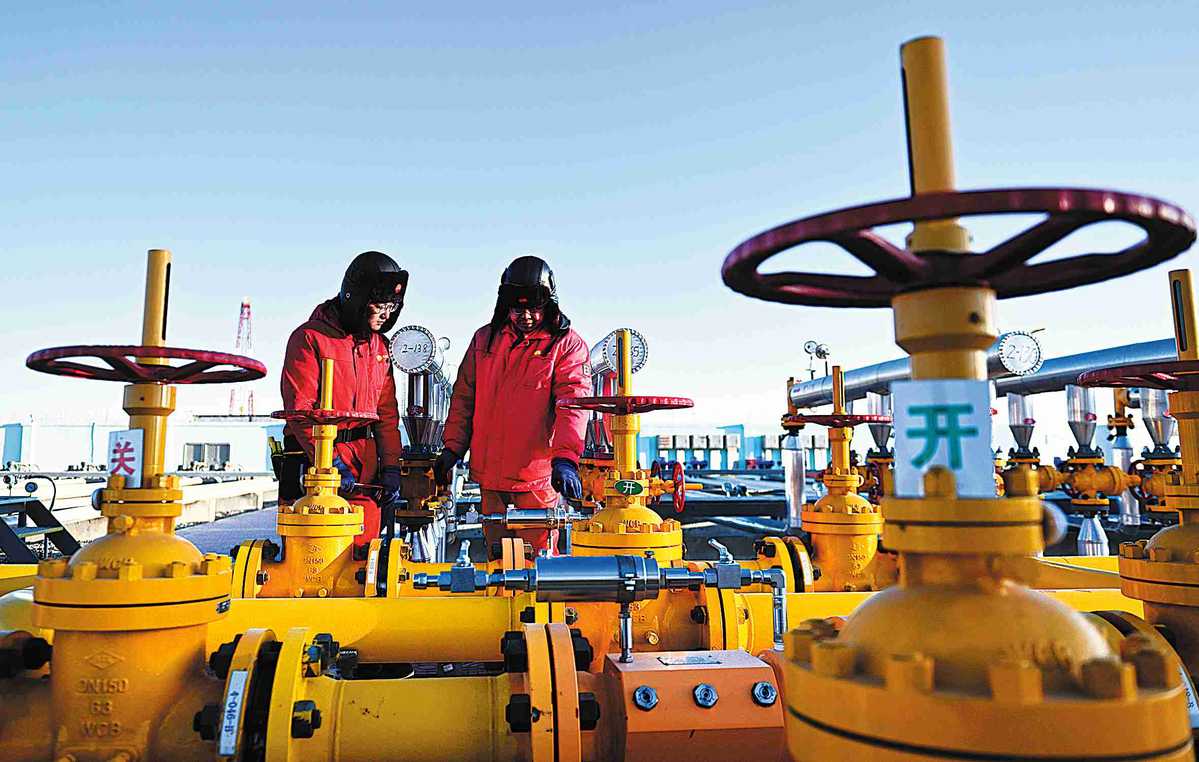Nation more energy self-sufficient


Power sector distancing itself from reliance on fossil fuel imports
China is becoming more self-sufficient in energy supplies thanks to rising domestic oil and gas production in recent years, with the energy self-sufficiency rate reaching more than 80 percent in 2021, according to a recent report.
China's energy self-sufficiency rate has been on a steady growth track in recent years, with the country's total energy production rising to 4.18 billion metric tons of standard coal last year, up 2.5 percent year-on-year, according to the China Offshore Energy Report released by the CNOOC Energy Economics Institute, a think tank under China National Offshore Oil Corp-China's top offshore oil and gas driller.
The country's domestic crude and gas production reached a record high last year, with domestic crude production expected to reach around 198 million tons in 2021 and further increase to 200 million tons in 2022, thanks to joint efforts by the country's oil majors, including China National Petroleum Corp, China Petroleum and Chemical Corp and CNOOC, it said.
As all the major energy players have been boosting capital expenditure in oil and gas exploitation and exploration in recent years to ensure sufficient energy supply in the country, oil consumption also steadily recovered in 2021 to 726 million tons, mostly used in the transportation, refining, architecture and industrial sectors. It is expected to further increase to between 736 million tons and 761 million tons in 2022, said the institute.
On the other hand, it also pointed out that the country's oil and gas dependency remains high. China imported around 513 million tons in 2021 with its oil dependency reaching around 72.7 percent.
China's domestic gas production and gas imports have also been on the rise. Natural gas production reached 207.5 billion cubic meters last year, up 7.8 percent year-on-year, with imports reaching 170 billion cubic meters, up 19.4 percent year-on-year.
The gas dependency rate rose to 46.1 percent in 2021, with liquefied natural gas imports accounting for 65.9 percent and pipeline imports 34.1 percent.
LNG distributors in the country have been ramping up efforts in infrastructure facility construction in recent years. By the end of September, China had 22 LNG receiving terminals put into operation with a total receiving and uploading capacity of 88.6 million tons per year.
One new LNG terminal was put into operation in 2021-Jiaxing LNG terminal-with a receiving capacity of 1 million tons per year. Two LNG terminals finished scale expansion including Jiangsu Rudong terminal, which has a newly added receiving capacity of 2.25 million tons per year, and ENN Zhoushan LNG terminal with an expanded receiving capacity of 2 million tons annually, it said.
By the end of 2021, the receiving capacity of the country's LNG terminals is likely to have reached 93.85 million tons per year, it said.
Gas storage facilities have also entered a rapid development phase in China in recent years. By the end of June, China had 14 underground gas storage clusters that included 27 underground gas storage tanks. Working gas volume was around 14.7 billion cubic meters, up 9.2 billion cubic meters compared with that of 2015.
China's underground gas storage volume is expected to have reached 18.2 billion cubic meters in 2021, up 3.5 billion cubic meters compared with 2020, it said.
However, it only accounts for 4 percent of the country's total consumption and is way behind the global average of 12 to 15 percent, so there is a long way to go, said an analyst.
"Under a strong government push to enhance gas supply security, China further accelerated underground storage build-out in 2021 with the commissioning of three expansion projects and five new storage facilities," said Li Ziyue, an analyst with BloombergNEF.
"Nevertheless, the share of working capacity in total gas consumption is still much lower than the international average. More storage capacity needs to be in place to meet seasonal and regional rebalancing demand."
Luo Zuoxian, head of intelligence and research at the Sinopec Economics and Development Research Institute, said the country's major oil and gas players have been accelerating exploration investment intensity during the past few years with their mastery of oil and gas exploration technology gradually on the rise, which will further inject momentum into the reform of the country's future oil and gas systems and mechanisms.
With joint efforts by the country's oil majors, China has achieved several major breakthroughs in both conventional oil fields and unconventional oil and gas sectors, including major breakthroughs in Daqing Oilfield in Heilongjiang province and Shengli Oilfield in Dongying, Shandong province, both of which have helped ensure the country's energy security, Luo said.
Daqing, owned by Daqing Oilfield Co, a subsidiary of China National Petroleum Corp-the country's largest oil and gas company-h(huán)it a significant milestone in its annual tertiary oil recovery in December, which has exceeded 10 million tons over the past 20 years. The oilfield has also produced 286 million tons of crude oil so far, making it the world's largest tertiary oil recovery production base, after the company spent years developing a series of fully developed tertiary oil recovery technologies, also known as enhanced oil recovery, or the third stage used to extract oil from an oil reserve.
Daqing has been able to maintain sustainable and steady oil output on the back of its technological innovation during the past few years, Luo said.
On the other hand, the country has also been making major commitments to transitioning its energy systems toward renewables, especially power generation from solar, wind and hydro sources.
While coal still accounts for a 66.9 percent share of the country's energy mix, according to the National Energy Administration, renewables are steadily increasing, with 17.6 percent coming from renewable energy power generation and 3.1 percent from nuclear power, it said.
According to the report, clean and low-carbon energy has been rapidly developing in recent years and accounts for 25.6 percent in 2021, compared with 24.2 percent in 2020, 17.8 percent in 2015 and 13.4 percent in 2010. Natural gas accounted for 9.2 percent while nonfossil fuels accounted for 16.4 percent.
With energy consumption intensity continually decreasing, the institute estimates clean energy will further increase.
Carbon emissions related to energy are also entering a slow growth period, reaching around 9.97 billion tons last year, up 0.8 percent year-on-year and 2.6 percentage points lower than the energy consumption growth rate.
The institute estimates that the energy demand will maintain a slow growth during the 14th Five-Year Plan period (2021-25).
China's total energy consumption in 2022 is expected to be 2.5 percent higher compared with the previous year. The share of oil in China's energy mix will fall to 19.5 percent this year. The share of natural gas will increase to 9.5 percent and that of nonfossil fuels will rise to 17.1 percent, it said.
According to a recently released report by Royal Dutch Shell, as the top producer of renewable energy as well as the leader in electric vehicle manufacturing and use, China has an important role in global climate change solutions.
China's pledge in 2020 to achieve peak emissions by 2030 and carbon neutrality by 2060 is a defining moment in the global decarbonization journey toward a more sustainable future and Shell believes it is economically and technically possible for China to achieve its ambitions.
It suggests several key actions to make progress this decade to put China on the pathway to carbon neutrality by 2060, including investing in reliable, renewable-based electricity networks and demonstrating technologies that transform heavy industry through hydrogen, bioenergy as well as carbon capture, utilization and storage (CCUS).
Shell also highlighted the importance of beginning an orderly transition away from coal and accelerating action through integrated policies, sectoral coalitions and making cities incubators of change.
China will need to massively scale up its CCUS capacity by more than 400-fold in the next four decades, it suggests.
"China is critical to the world achieving the goals of the 2015 Paris Climate Agreement," said Mallika Ishwaran, chief economist, Shell International.
"The 2060 carbon neutrality target is challenging, but it also creates opportunities to position China as the global leader in low carbon manufacturing. With early and systematic action, China can deliver better environmental and social outcomes for its citizens while being a force for good in the global fight against climate change."




































